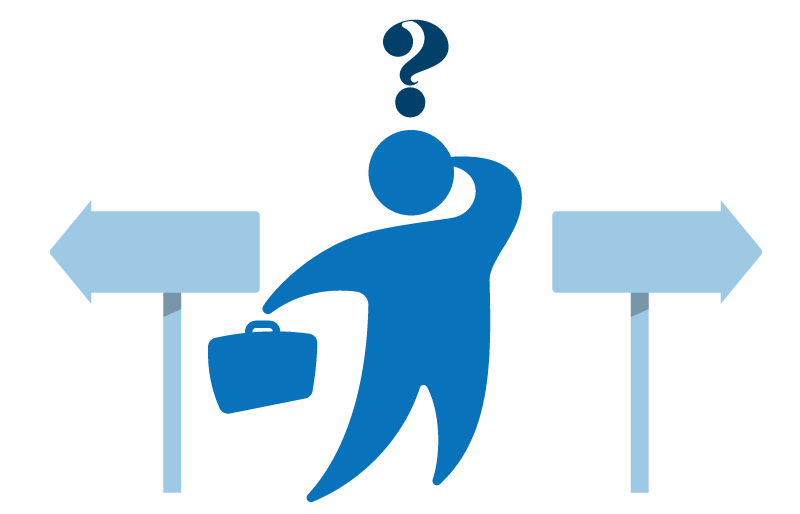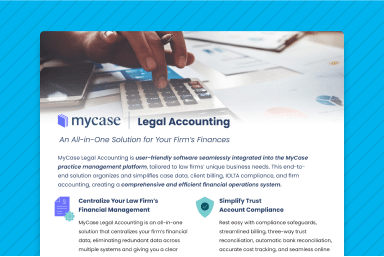The Ins And Outs Of Buying A Law Firm [eBook]

The following blog post is from the MyCase eBook “The Ins and Outs of Buying a Law Firm” by Roy Ginsberg. You can download the full PDF for free here.
Historically, when most lawyers set up their own law firms, they started them from scratch. This brought on the unavoidable headaches that go along with starting anew. In today’s legal profession, however, there are opportunities to buy existing practices and hit the ground running.
Depending upon the practice area and its location, it may make more economic sense to buy a practice, rather than build it the old-fashioned way. And there could be abundant opportunities to do so as more and more boomer lawyers retire.
Buying an existing legal practice has its advantages:
- You have work to do right away
- You gain access to a built-in referral network
- Your book of business is full of vetted, paying clients
- Your phone rings and your website gets visitors
- You have predictable costs
- You may even gain access to a willing mentor
Law Firms Can Be Ethically Bought and Sold
For years, buying a law practice was prohibited. Ethics regulators believed that clients, files, and a firm’s goodwill were simply not for sale. This prohibition had no real impact on larger law firms, since partners could be bought out and the partnership would return the equity owned by the retiring partner. Even smaller law firms could “sell” themselves under the guise of a merger.
But solos were forced to be creative. Some sold the firm’s physical fixtures and furnishings for more than market value. Others created sham partnerships, whereby the “selling” lawyer received retirement benefits from the new partner. Still other solo practitioners either handed off their clients to other lawyers or just simply closed up shop, forcing their clients to fend for themselves.
This all started to change in 1989 when California became the first state to adopt a rule allowing the sale of a practice. The following year, the ABA adopted Model Rule 1.17, which permitted the sale of an entire practice. The Rule was later amended to allow the partial sale of a practice. To date, the vast majority of states have adopted Model Rule 1.17 as is or in a modified version.
The policy change was largely driven by a desire for transparency and to level the playing field between solos and firms of all sizes. Furthermore, ethics regulators thought it better to have client matters taken over by a seller-screened lawyer rather than making clients find alternate counsel.
What Kind of Practice Should I Buy?
Predictable Revenue
When purchasing a law practice, buyers hope that past clients will “keep the phone ringing” even though the selling attorney is no longer there.
For some practice areas, this will not happen. Very prominent criminal defense attorneys and other well-known litigators are good examples of practices where future revenue is very problematic. These practices are too closely tied to the sellers’ reputation. Buyers will soon learn that clients want to hire only the lawyer who is selling and nobody else.
However, some practice areas are likely to generate future revenue.
Old Files That Keep Giving
Estate planning practices may well produce future revenue despite the departure of the lawyer who first opened the files. For example, if a buying lawyer inherits files containing wills for living clients, it is reasonable to assume that some of those clients will want to revise or update their wills, especially if the buyer actively markets to past clients. Furthermore, client deaths may lead to probate proceedings.
While future revenue may be likely, it is impossible to predict how much. One cannot predict how many clients will want to have their estate plans revised. Furthermore, even for those clients who do need such work, some may prefer to use other counsel other than the buyer.
Some Client Relationships May Be Transferable
Other practices that may yield future revenue are those where the retiring lawyer’s book of business is based upon close personal relationships with clients or referral sources. When such a practice is sold, the selling lawyer can make an introduction and vouch for the buying lawyer. Ideally, the relationship will then transfer and the business will continue.
One example of such a practice in this category is an IP lawyer with a patent-prosecution practice who has relationships with key general counsels or lead scientists at a few companies. Another potential in this category might be an immigration lawyer whose clients are corporations with foreign-worker issues, where key relationships are with human resource VPs. Still another would be a small-business attorney who has referral relationships with select CPAs. In all of these practice area scenarios, a successful transfer of the relationship should lead to future revenue.
Just like the situation with the estate planning practice, however, the amount of future revenue is unpredictable. If a retiring lawyer’s book of business is based on eight key relationships, there is no guarantee that there will be eight smooth transitions. It is reasonable to assume that some of the relationships will transfer—it is impossible to predict how many, however.
Contact Information
For certain consumer practice areas, a website domain name, email address and phone number should generate future revenue. For example, a bankruptcy lawyer with a well-trafficked website and an address of www.nodebts.com, along with a phone number of 1-800-NO-DEBTS, should continue to attract business after the seller is gone. In these situations, the phone keeps ringing when a buyer takes over because clients find the firm by searching on Google. It does not matter whether the seller is present.
Brands
The name or brand for some law firms may have value under certain circumstances. Let’s assume that the law firm’s name at nodebt.com is the No Debt Law Firm. If that name has been and continues to be advertised on billboards, radio, TV, and the Web, some consumers wanting bankruptcy assistance will contact the law firm simply because they remember the name and the contact information. The brand stands on its own. Here again, the presence of the previous owner-seller is largely irrelevant in determining future revenue.
Systems and Operations
Finally, there are also some practices that have value based on their systems and operations. This can be true for certain niche practices that are usually high volume. These firms often resemble a “factory” type of business, rather than what one traditionally thinks of as a law firm. Examples include plaintiff bankruptcy and defendant mortgage foreclosure firms. For these practices, a buyer purchases the means to get the work done (staff, equipment, procedures, etc.) and avoids the headaches of creating them.
How Much Should I Pay?
At the risk of sounding cliché, a law practice is worth exactly what someone else is willing to sell it for.
Although that answer may not be satisfactory, valuing a law practice is different from valuing other professional services businesses. In other settings, expert appraisers routinely apply a variety of formulas. They can do this somewhat confidently, because such services—including accountancies and medical or dental practices—have fairly predictable future books of business.
In contrast, an attorney’s book of business is much harder to predict. Using the examples from above, how many former clients will actually want to revise their estate planning documents? Does a buyer really know how many small business owners will continue to work with the buying attorney?
Buying a Law Firm Is Not Like Getting a Divorce
Using values of law practices from divorce proceedings is of little use. In a divorce setting, there is some amount of certainty about the amount of business in the future for a lawyer getting divorced. Few factors change. If an attorney has grossed $200,000 each year for the past three years, it is reasonable to assume that those numbers will not change substantially in the near future. When a law practice is sold, many factors could change, thereby impacting future revenues.
Moreover, when divorcing, husband and wife must strike a deal or a judge will do it for them. There is no court lurking in the background creating an environment to motivate the parties to strike a deal in a buy-sell arrangement. Either party can walk at any time.
Comparables
Unfortunately, comparables don’t help either. The marketplace for buying law firms is an immature one. Comparable sales are potentially nonexistent. More importantly, there are few ways to find out what the law practice across town sold for. Deals are confidential. Unlike in the real estate market, there are no weekly listings of what sold and for how much.
Even if one could learn about a deal’s terms, it would still be difficult to use them as comparables. Many deals happen with insiders, and are not arms-length transactions. Here, the value is usually “what seems fair” in light of the history of the parties’ relationship. That same “fairness” is not present when buying a firm from a stranger.
Estate Planning Hypothetical
As noted earlier, estate planning practices have value. If you are considering the purchase of such a practice from a solo practitioner that has consistently grossed $200,000 annually in revenue, how much should you pay?
Let’s make a few assumptions. Over the years, the seller drafted 1,500 wills for clients. Over the next five years, you hope that 200 of them will retain you to update their wills (@ $1,000 per will) and 60 more die and you probate the estate (@ $5,000 per probate).
Here, you hope to obtain an additional $500,000 (200K + 300K) in revenue over the next five years. Of course, you don’t ever really know how many revisions and probates will actually occur.
Two Valuation Methods to Consider
When valuing law practices, I use two methods that are relatively easy to understand; the “rule-of-thumb” and the “earn-out.”
The Rule-of-Thumb Method
Accountants select a variable (also known as a multiple). They then multiply the annual gross revenue by the multiple to obtain a value. In other service professions where future revenue is more predictable than in the legal profession, this method makes sense.
For example, for accountants, the conventional wisdom is that the starting point for accounting practice valuations is one times gross. Using a multiple is logical in the accounting world because there should be predictable revenue; clients have their tax returns prepared annually.
Using a multiple is not necessarily logical for law practices. While an estate planning practice may have predictable revenue, many other practice areas do not. As explained earlier, a prominent criminal defense has virtually nothing to sell.
Even though the predictability of revenue significantly varies by practice area, many people who write about law practice valuations still try to use multiples as a valuation method. Although there is absolutely no science to support one multiple over another, some believe the number to be between 0.3 and 1.0.
For our example, let’s use a conservative multiple of .5. Thus, applying the rule-of-thumb method, the value of the estate planning practice is .5 of $200,000, or $100,000.
The Earn-Out Method
Buyers pay an “earn-out,” which is a percentage of future revenue for a fixed time period. Using the same example, if the actual revenue from the seller’s files averages $100,000 per year over five years, the buyer pays an agreed percentage of that revenue.
Let’s assume the percentage is 20%. Why 20%? Much like the multiples of the rule-of-thumb method, there is no science to support this figure. Anecdotally, however, this percentage seems to be used by at least some parties.
Earn-out percentages are easier to grasp if you think of an earn-out percentage as a hybrid of a referral fee. For personal injury practices, 33-40% seems to be the magic number. In the seller-buyer scenario, however, where both parties wish for a steady stream of “referrals,” they usually agree to lower percentages. This makes sense.
Some sellers may be tempted to seek higher percentages. But if the percentage is too high, buyers may not be sufficiently motivated to market the seller’s files. Buyers may be better off concentrating their efforts on finding new clients of their own where they can keep all of the revenue and won’t have to share it with the seller.
At 20%, the amount the seller eventually receives is the same $100,000 as under the rule of thumb, if the term is five years.
Remember, both methods are very inexact. Under the rule of thumb method, there is a lot of wiggle-room when estimating future revenue, as well as with the choice of a somewhat arbitrary variable or multiple. With the earn-out method, the percentage figure can be a moving target. Furthermore, as a buyer, you won’t know the precise sale price until years down the road.
Terms & Risks
For both types of deals, terms are relatively straightforward. Once parties agree to a rule-of-thumb price, the next step is to negotiate a payout schedule. Under an earn-out deal, parties negotiate two basic terms: the percentage and the length of time payouts are due.
It goes without saying that, much like all business transactions, buying a law firm involves a level of risk. If there is a fixed price, the buyer may end up paying something for nothing if the future revenue is less than estimated. The contrast, of course, is that if future revenue exceeds expectations, buyers get a really good deal.
Under an earn-out, buyers assume little risk other than perhaps losing a negotiated down-payment. If minimal future revenue materializes, the buyer doesn’t pay much. The flip side is that if future revenue exceeds expectations, the buyer pays more.
Most buyers prefer the less risky earn-out method. Not surprisingly, most sellers prefer the certainty of fixed payments and try to avoid the risk of negligible future earn-out payments.
After the Deal Is Done
Once a sale is final, the seller must take action. Specifically, under Rule 1.17, a seller must notify his or her clients in writing that the practice will be sold, that they can hire a lawyer other than the buyer and have their file returned, and that consent will be presumed if the client does not take action or object within 90 days of receiving the notice. Without this notice (if a client cannot be found, for example), a court order is necessary to transfer the representation to the buyer.
A sale cannot increase the cost of representation. Under Rule 1.17, buyers cannot increase fees to recoup the purchase price for one year.
Of Counsel
One way to avoid the requirements of Rule 1.17 is to make the retiring lawyer “of counsel” with the buyer’s firm. By doing so, there is no actual sale, and Rule 1.17 does not apply.
The term “of counsel” is not defined in the Model Rules. The ABA defines it as a “close, regular, personal relationship” with the law firm. So long as the relationship is bona fide and not a sham, state regulators should have no problem with such an arrangement.
Moreover, the “of counsel” alternative can be a very attractive means to structure a succession arrangement for those retiring lawyers who still want to practice on a limited basis during their final years of practice.
Know Where There’s Value
In conclusion, if you are thinking about buying a law practice, it’s all about future revenue. Under most circumstances, only buy a practice that you believe will have the potential for predictable future revenue. Ask yourself whether the phone will keep ringing after the seller is gone. If you think it will, then move forward and reap the benefits of buy a well-established practice instead of starting from scratch!








